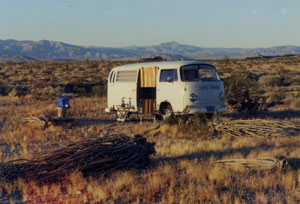Brief Author Q&A for Adobe Flats
Interview with Ken Wilkerson conducted via email, Darvey-Raignes, Publishers
Adrian Raignes: Good evening, Ken. In this interview for Adobe Flats I want to begin with a few questions about writing.
KW: Sounds a bit stuffy, Adrian.
AR: It won't be. To start off, what is your background? Your impetus as a writer?
KW: While growing up, I received a public school education, so I provided most of my "formal" education by reading books. My world-view was partly shaped by a variety of authors - my other learning was primarily through life experience, following intuition, spending time with individuals from other cultures and backgrounds. As a young adult I began expressing my particular part of the human experience, presenting my world with honest descriptions of my feelings and observations.
AR: Where did you live then?
KW: Besides many years in Los Angeles, I lived in the desert, in small towns, and spent my free time roaming backroads and camping in remote areas of the natural world. I researched old books about previous inhabitants, from Native American tribes to Spanish explorers, miners and regional characters, which provided a solid foundation when I explored the backcountry and discovered relics of the past. When I came upon an ancient Indian village site, mining camp, or slept in a forgotten graveyard, I knew who'd lived there and what their lives were like. The open desert was alive with spirits of the past.
AR: How did you begin writing?
KW: When I began writing I chose to be self-taught, to maintain purity of expression. Original self-expression is an offspring of walking a road untraveled by others, so I felt that authenticity can be lost if a work is the result of collective consensus, fabricated within a classroom. Creating is solely personal - as you know, navigating the subconscious can't be taught.
AR: Do you prefer writing fiction or non-fiction?
KW: Usually fiction. After writing pieces of fiction and non-fiction, I was aware of the distinct differences in composition. Journalism and non-fiction are similar to verbal communication, whereas fiction's a separate language, involving one's inner life and the subconscious. Creating it is inhabiting an alternate world, birthing characters and sustaining linear narrative for weeks or months. I once heard an interview with a novelist who described himself as "a walking haunted house."
AR: Expound on the process of creating.
KW: Relating it from my experience (and I assume every other writer's) the process involves slipping away from my everyday state of awareness, engaging my inner voice. The onset of a story is the beginning of a journey within, describing what I visualize and, in a sense, transcribing what the characters speak. (Occasionally, my characters decide what direction a scene will move; sometimes they'll appear in my dreams at night and reveal something about themselves). As a story unfolds, I write page by page - I never rewrite, to avoid adulterating anything that transpired. The details and various elements that enter a story are part of what I've absorbed through direct experience; some come from another place, which is part of the mystical aspect of fiction. Finally, when a story concludes, the journey's over, my prose voice is disengaged until another begins.
AR: How do you normally work?
KW: I've always written by hand, which for me is the most natural way of transferring thoughts to paper. I use tablets of unlined paper and write in solitary settings, camped in the badlands, or in decrepit hotel rooms around the border country. Imagination is the primary tool, though a view of a somnolent street below, a glass of mescal, the vibes of long-forsaken tenants may sometimes evoke particular emotions. Another ideal spot is the floor of my camper van, where I scribble way with the sounds of a breeze rustling through creosotes. When I return home I type up my handwritten pages and edit.
AR: Have you encountered any pitfalls?
KW: Fortunately, my writing-related experiences have been dilemma-free. Last weekend I met a writer in Santa Cruz who'd been a victim of plagiarization. Presumably, a plagiarist steals without the realization that the preyed-upon work is part of the essence of its author. One can get shot for stealing a TV, yet remain un-prosecuted for stealing a heart and soul. It's no mystery why many writers, painters, musicians have been drunkards and addicts - those are symptoms of the misconception and censure of artists.
AR: An off-the-wall question: What is your definition of art?
KW: Art is an expression of one's perception of the world, a documentation of the truths in one's life. As a writer, if you've achieved those in the body of work you've created, derived joy from the hard work and discipline, then you've succeeded.
AR: Finally, how about some words on Adobe Flats? You've already provided the background.
KW: Adobe Flats is a mix of fiction and non-fiction stories with scenarios somewhat removed from mainstream life. Authentic details help transport the reader into the faraway towns and landscapes. The primary characters are searchers, sovereign spirits whose lives are shaped by the rhythms of the natural world. Readers can hook up with them, go on a windswept ride, chase the mirage. Adobe Flats offers the feeling of the genuine California desert experience, particularly as lived beyond the ongoing encroachment occurring in the American Southwest.
AR: I will add that the book is eclectic and immensely entertaining.
KW: Many thanks, Adrian. The Guinness will be on me when we reconnect.
